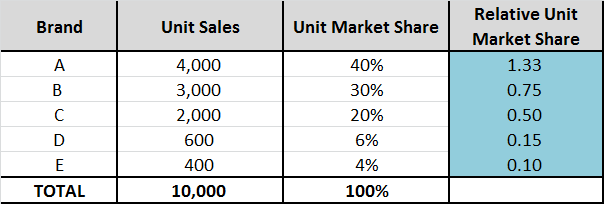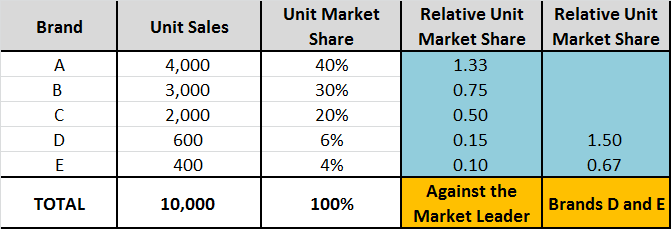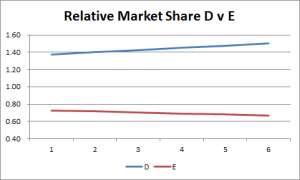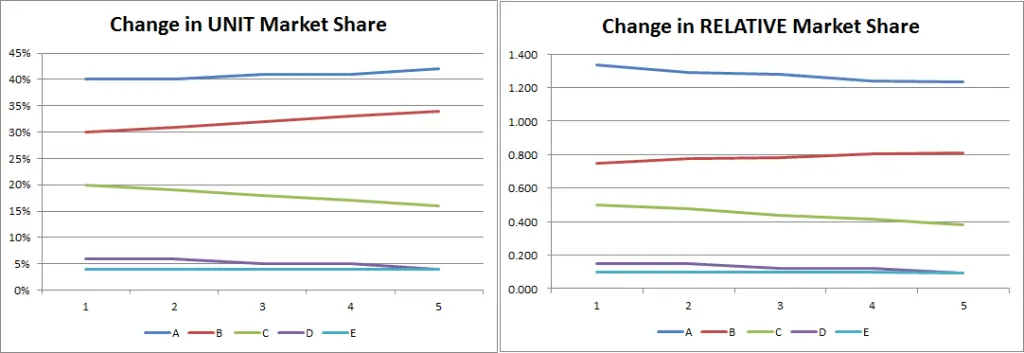Get the: relative market share template
Contents
Relative Market Share (RMS) is a measure of a company’s performance in comparison to its competitors. It is calculated by dividing a company’s own market share by the market share of its largest competitor.
This ratio provides a perspective of how well the company is doing relative to its biggest competitor, rather than looking at its market share in isolation.
A relative market share greater than 1 indicates that the company is the market leader, as it has a larger market share than its nearest competitor. Only one firm in the market will have a relative market share greater than 1 – and all other players will have a relative market share as a percentage of the market leader.
The concept of relative market share is often used in portfolio analysis tools like the Boston Consulting Group (BCG) Matrix, where it serves as one axis on the grid, representing market dominance. The higher the relative market share, the higher the company’s cost advantages over its competitors due to economies of scale and experience.
Relative market share has several advantages over using normal or absolute market share, including:
Competitive Benchmark = It gives a comparison with the strongest competitor in the market, providing an understanding of a brand’s relative competitive strength.
Potential Competitive Advantage = A high relative market share can indicate potential strategy options, as the brand/company is likely to have better economies of scale, or stronger customer loyalty compared to the nearest competitor.
Strategy Planning = As indicated above, relative market share is input into the BCG matrix, which may be helpful in terms of allocating resources across a more complex business portfolio.
More Reflective of Market Conditions = Relative market share is probably more reflected in industries that are highly concentrated, and are more likely to be a duopoly or an oligopoly.
Yes you can – and is often a better metric to consider than a relative market share against the market leader.
Indeed, for many small firms, this may be a relatively meaningless metric.
Instead these firms might vary the calculation of relative market share to include just their direct competitors. To further consider this, let’s take the example of the five brands shown here.
In the case above, Brand D and Brand E may be more interested in bench-marking themselves against each other – especially if they are more direct competitors and as they are both relatively small players in the market.
The relative market share between brands D and E would be as follows (and as shown in the table):
- Brand D = 6%/4% = 1.50
- Brand E = 4%/6% = 0.67
In this case – and probably more appropriate for most small brands – it would be better to recalculate the relative market share metric to benchmark themselves against firms or brands around their own size.
A more dynamic marketing metric
As you can see, this metric will be more dynamic as a result, and will be more important to track over time.
Both of these brands would probably have some form of marketing goal to outperform the other brand, and so this is an easy metric to monitor that progress – as is shown in the line graph of relative market shares between Brand’s D and E over time.
In this case, Brand E is actually holding their unit market share, but because their direct competitor (Brand D) is increasing their market share, the relative market share metric more clearly shows Brand E’s deteriorating competitive position.
This is also highlighted in the following two graphs where the underlying market share information is identical. As you can see, in the first chart of unit market share, the market leader’s position seems strong, whereas relative market share graph indicates that it is declining relative to its major competitor.
What is Relative Market Share (RMS)?
RMS is a measure of a company’s performance compared to its competitors. It’s calculated by dividing a company’s market share by the market share of its biggest competitor.
How is RMS different from absolute market share?
Unlike absolute market share, which shows a company’s portion of the total market, RMS shows a company’s market share relative to its largest competitor.
What does it mean if a company’s RMS is greater than 1?
If a company’s RMS is greater than 1, it indicates that the company is the market leader (ore the largest player in the calculation), holding a larger market share than its nearest competitor.
Can RMS be used to analyze market shares against non-market leaders?
Yes, it can. For smaller firms, it might be more meaningful to calculate RMS against direct competitors of a similar size, rather than against the market leader.
Why is RMS important for competitive benchmarking?
RMS provides a comparison with the strongest competitor in the market. It offers an understanding of a brand’s relative competitive strength, making it a valuable tool for competitive benchmarking.
How can a high RMS indicate potential strategy options?
A high RMS can indicate that the brand/company likely has better economies of scale or stronger customer loyalty compared to the nearest competitor. This can open up potential strategy options like price competitiveness or customer retention strategies.
Further Information




